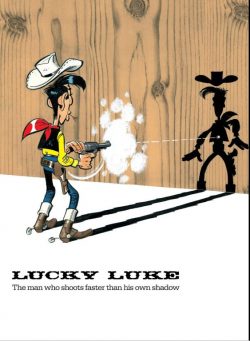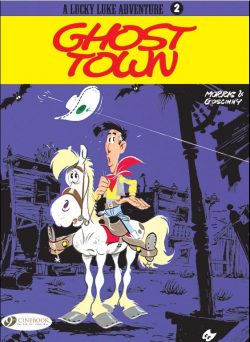

By Morris & Goscinny, translated by Luke Spear (Cinebook)
ISBN: 978-1-905460-12-0 (PB Album)
It’s hard to think of one of Europe’s most beloved and long-running comics characters being in any way controversial, but when the changing times caught up with the fastest gun in the West (“so fast he can outdraw his own shadowâ€) and the planet’s most laconic cowboy moved with them, the news made headlines all over the world.
Doughty yet dependable cowboy champion Lucky Luke is a rangy, good-natured do-gooder able to “draw faster than his own shadowâ€. He amiably roams the fabulously mythic Old West, enjoying light-hearted adventures on his rather sarcastic know-it-all wonder-horse Jolly Jumper. The taciturn nomad constantly interacts with a host of historical and legendary figures as well as even odder folk…
His unceasing exploits over 7 decades years have made him one of the best-selling comic characters in Europe – if not the world – generating upwards of 85 individual albums and sales totalling in excess of 300 million in 30 languages… so far…
That renown has led to a mountain of spin-off toys, computer games, animated cartoons, a plethora of TV shows and live-action movies and even commemorative exhibitions. No theme park yet but who knows when…?
The brainchild of Belgian animator, illustrator and cartoonist Maurice de Bévère (“Morrisâ€) and first seen in Le Journal de Spirou‘s seasonal Annual L’Almanach Spirou 1947, Luke sprang to laconic life in 1946, before ambling into his first weekly adventure ‘Arizona 1880’ on December 7th 1946.
Working solo until 1955, Morris produced nine albums of affectionate sagebrush spoofery before teaming with old pal and fellow trans-American tourist Rene Goscinny, who became regular wordsmith as Luke attained dizzying, legendary, heights starting with Des rails sur la Prairie (Rails on the Prairie). This began serialisation in Spirou on August 25th 1955.
In 1967, the six-gun straight-shooter switched sides, joining Goscinny’s own periodical magazine Pilote with ‘La Diligence’ (The Stagecoach).
Goscinny co-created 45 albums with Morris before his untimely death, from whence Morris soldiered on both singly and with fresh collaborators.
Morris died in 2001, having drawn fully 70 adventures, plus many spin-off sagas crafted with Achdé, Laurent Gerra, Benacquista & Pennac, Xavier Fauche, Jean Léturgie, Jacques Pessis and others, all taking their own shot at the venerable vigilante…
Lucky Luke has previous in this country too, having first pseudonymously amused and enthralled British readers during the late 1950s, syndicated to weekly anthology Film Fun. He later rode back into comics-town in 1967 for comedy weekly Giggle, where he used the nom de plume Buck Bingo.
In each of these venues – as well as many attempts to follow the English-language album successes of Tintin and Asterix – Luke laconically puffed on a trademark roll-up cigarette which hung insouciantly and almost permanently from his lip. However, in 1983 Morris – amidst pained howls and muted mutterings of “political correctness gone mad†– deftly substituted a piece of straw for the much-travelled dog-end, thereby garnering for himself an official tip of the hat from the World Health Organization. For historical veracity, that tatty dog-end has been assiduously restored for this particular tale and indeed all of Cinebook’s fare – at least on the interior pages…
The Kent-based Euro-publisher is the most successful in bringing Lucky Luke to our shores and shelves, and it’s clearly no big deal for today’s readership as we’re at 74 translated books and still going strong…
Moreover, apart from that very first adventure, Lucky, to misappropriate a quote applied to the thematically simpatico Alias Smith and Jones “in all that time he never shot or killed anyoneâ€â€¦
Originally collected in 1965 as La Ville fantôme, the 25th adventure and Goscinny’s 16th collaboration with Morris is available in English as an oversized paperback – and digitally too as Ghost Town: the second of the Cinebook series.
It all begins as Luke rides the range and encounters tarred-and-feathered gamblers Denver Miles and Colorado Bill. Despite instantly assessing their scurrilous natures – and naturally they subsequently try to rob him – Lucky gives them assistance and a ride to the nearest outpost of civilisation.
That happens to be the deserted mining town of Gold Hill where they encounter embittered aged miner Old Powell who chases them off at gunpoint.
A little further on they reach Bingo Creek and discover the mad old coot was once the victim of a gold-salting scheme (hiding gold on worthless land and getting a sucker to buy it) but stubbornly refused to quit, convinced that somewhere in his mountain the motherlode still lies hidden…
Denver and Colorado are incorrigible crooks and after Lucky exposes their fleecing of the townsfolk the bent gamblers try to backshoot him, only to fall foul of Powell’s skill with a rifle…
Eternally grateful, Lucky determines to befriend and assist the irascible old coot, despite all his surly protests, whilst Denver and Colorado sketch out the perfect revenge by attempting to steal his mine to re-salt and sell on to some other sucker…
To this end they try to buy up the claim, have Old Powell hanged for witchcraft, frame him for cattle-rustling and even plant the stolen cash-register from the saloon in his mine. The scoundrels haven’t reckoned on the ingenuity of Lucky Luke, however…
Against the masterful wits and wicked wits of our indomitable hero the gamblers are ultimately helpless in this splendidly intoxicating blend of all-ages action, slapstick and wry cynical humour.
Although the dialogue is perhaps a bit dry in places, this is a grand old hoot in the tradition of Destry Rides again and Support Your Local Sheriff (or perhaps Paint Your Wagon,Evil Roy Slade or Cat Ballou are more your style?), superbly executed by master storytellers and offering a wonderful introduction to a unique genre for modern kids who might well have missed the romantic allure of the mythical Wild West.
And in case you’re worried, even though the interior art still has our hero chawin’ on that ol’ nicotine stick, trust me, there’s very little chance of anyone craving a quick snout, but quite a high probability that they’ll want more to binge on loads more Lucky Luke…
© Dargaud Editeur Paris 1971 by Goscinny & Morris. © Lucky Comics. English translation © 2006 Cinebook Ltd.
